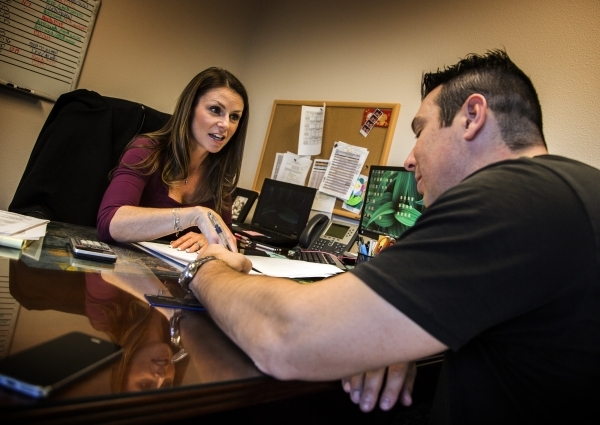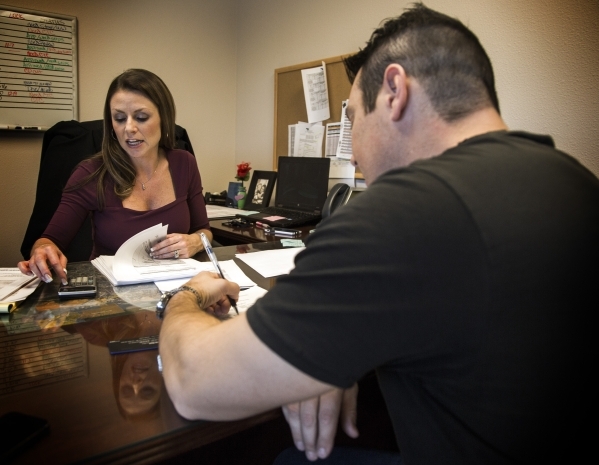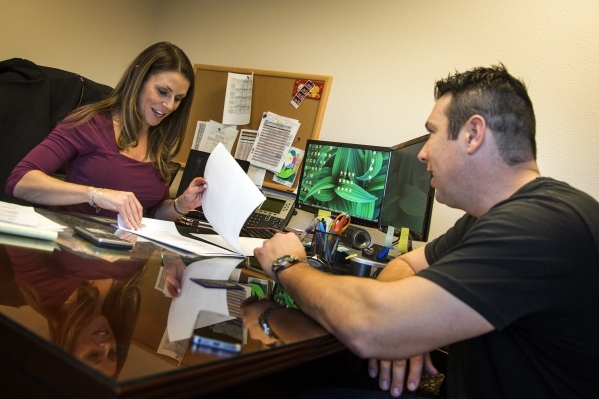Hint of rising interest rates may move valley homebuyers off the sidelines
The prospect of rising mortgage rates in 2016 may serve as an impetus to bring people off the sidelines and buy a new or existing home, Southern Nevada housing analysts say.
Higher interest rates have the potential of shutting out some first time homebuyers by making it more difficult for them to qualify, and move-up buyers eyeing more expensive homes want to lock in the lowest rate possible to hold down mortgage payments, analysts said.
The 30-year fixed mortgage rate has crept up since the end of October from 3.76 to just under 4 percent, nearly unchanged from a year ago. Anticipation that the Federal Reserve in December for the first time in nearly a decade will raise the federal funds rate — the interest banks charge each other overnight — has captured the attention of Realtors, homebuyers and bankers. That short-term rate can influence lending to consumers, including mortgage rates.
Some buyers aren't taking any chances by moving ahead with their purchases now. Southern Nevada home sales remain strong, up 4.7 percent in October and are ahead of the pace of 2014, according to the Greater Las Vegas Association of Realtors. Condo and townhome sales rose 9.2 percent in October.
Because mortgage rates have been so low for years, many people don't pay attention. But that could change for prospective buyers if the Federal Reserve acts, GLVAR President Keith Lynam said.
"Generally when interest rates start to creep up and people hear about it, that will motivate them to get ready sooner than they would to buy a home," Lynam said. "It may spur some things."
Rush to refinance?
Mike Gould, senior vice president of mortgage lending at Nevada State Bank, said conventional mortgage rates of 3 percent to 4 percent have been consistent since the Great Recession. If the Fed raises its fund rate a quarter percent to stem a potential increase in inflation, Gould said he expects more activity in the housing market and more existing homeowners to refinance their loans.
"What we typically see as the Fed moves is there will be a rush to refinance because of the perception that rates will increase," Gould said. "We won't actually get a rapid rise in interest rates, but we will see a push from the consumer to get that application done before they see another rise in interest rates."
The group most vulnerable to a rise in mortgage rates is first-time homebuyers, and their ranks have been decreasing in the marketplace, Gould said. About 60 percent of all transactions were first-time homebuyers four years ago, but that's expected to drop to 40 percent to 45 percent in 2016, he said.
"We are seeing a lot fewer first-time homebuyers choose to take the plunge and purchase a home," said Gould, who added they're renting homes instead.
"A lot of them have considerable debt coming out of college. Prior to the recession, there was a lot more flexibility with down payments. There was 100 percent financing programs that didn't require the consumer to put any money down. Those programs have mainly gone away. You're seeing a down payment requirement of 3 percent to 20 percent, depending on the type of program. A lot of our first-time homebuyers are having a hard time saving the money for a down payment for a new home."
Add in the potential for a 4.5 percent mortgage rate for conventional loans by the end of 2016, that more significant for first-time homebuyers than it appears on the surface, Gould said. A half-point jump in interest rates means $60 more a month on a $200,000 home, and that makes it more difficult for them to qualify, he said.
"Someone who was looking at a $200,000 home as their max budget, and now that interest rates have gone up and maybe they're down to $175,000, what's available in the market from a $175,000 to a $200,000 price range," Gould said. "It's much more limited than from a $200,000 to $300,000 price range."
Lynam said the biggest impact of rising mortgage rates will be on those who won't be able to qualify because of it. Because any increase will be small, he said, it won't have a dramatic impact on the real estate industry, especially in Southern Nevada.
"It doesn't help, but it's not as impactful as you might think," Lynam said. "When they're ready to buy a house, they're ready to buy a house. We're talking about interest rates right now where the only way you can get a lower interest rate is if you rob a bank and your favorite cousin in a judge."
Rising home values
The continued improvement in the Southern Nevada housing market remains evident with increased sales, but it continues to showcase itself with rising values. The median home price for sales in October was $220,000, a 10 percent increase over 2015, the GLVAR reported.
Gould said the rising values means many homeowners whose homes were underwater for years — they owed more on the mortgage than the homes were worth — will prompt them to take advantage before interest rates increase.
GLVAR stats show that the median price of single-family homes sold in Southern Nevada hit a high of $315,000 in June 2006 but dropped to a low of $118,000 in January 2012. Prices started rising again in 2012, increasing by 24 percent per year in both 2012 and 2013 before increasing at a slower pace in 2014 and 2015, according to the GLVAR.
"During the downturn, we had so many properties that were underwater and consumers could not take advantage of a cash-out refi," Gould said.
"Even at 4 percent on a cash-out refinance, that's a significantly lower rate than you're going to get for credit cards or some unsecured loan. If you want to pay off debt or do home improvements or any of those things you weren't able to do when you're home was underwater; now that we got some equity, you can pull some of that equity out."
The bounce-back in values is why home sales will remain strong in 2016 despite a rise in interest rates, Gould said. There's pent-up demand from homeowners hit hard by the Great Recession, unable to pull equity out of their home and unable to buy the next level of home until now, he said.
Many of those homeowners have enough money from the sale of their homes to use as a down payment, Gould said. A property that was underwater by 25 percent to 50 percent three years ago has bounced back. In the worst-case scenario, a homeowner owes 100 percent of the value of their home rather than 200 percent of the value some faced a few years ago, he said.
"We have gone years and years without seeing those clients move up, and now we're starting to see that," Gould said.
"They were our previous first-time homebuyers. They're families are bigger, and they're buying new homes. We're starting to see that in the luxury market as well. Somebody that may own a $500,000 to $600,000 house, and they're now moving up to new construction or an existing property valued at close to $1 million. We're very positive about what 2016 looks like."
Beating a rate hike
One Las Vegas resident who beat the prospective rise in interest rates is Tony D'Ambrosio, who closed on a home in early November in south Summerlin. The 4,400 square-foot, five-bedroom home, which sold for $150 a square foot, is an upgrade for the family of four. D'Ambrosio, 41, a casino host at the Hard Rock, said he was able to sell his home in Nevada Trails in the southwest valley for $120 a square foot and wound up with a similar mortgage payment by securing a 2.75 percent adjustable rate mortgage.
"It made it a lot easier to buy the house," D'Ambrosio said. "Right now if I waited, I don't think I would ever get that offer again. It would have gone up. I'm extremely happy."
Gould said many move-up buyers are going with an adjustable rate mortgage that is significantly lower than a 30-year fixed rate. For those who have seven-year adjustable rate mortgages with a 2.75 percent rate, the most it can increase is 5 percentage points to 7.75 percent, he said.
These adjustable rate mortgages aren't like the ones that ballooned and triggered problems for homeowners in the past decade, Gould said. It's an option for those not planning on living in their homes beyond seven years or for those who plan on paying off their mortgages before then, he said.
"A lot of consumers have a plan, and based on what they saw during the recession, it's to pay off their home as quickly as possible," Gould said.
Gould said those who have a regular paychecks and can prove their income are having no problem obtaining loans. There continues to be more scrutiny, however, on those who are self-employed and who rely on tip income, he said.
























